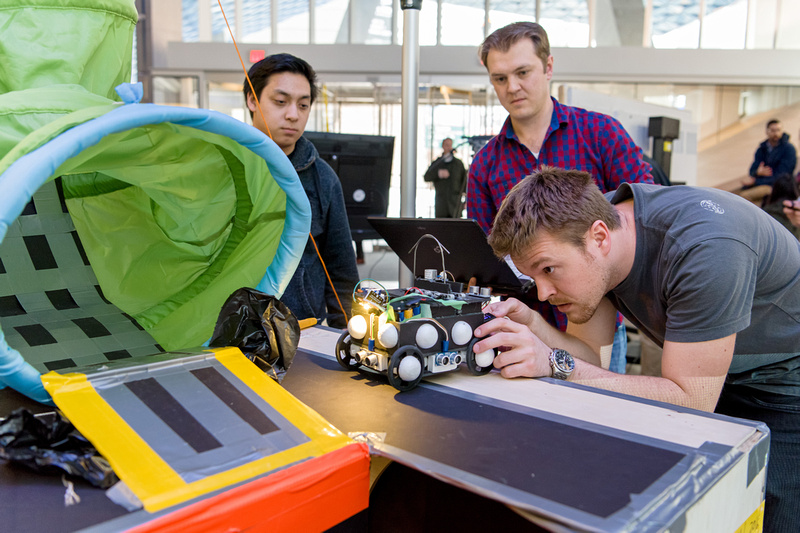Preserving Egyptian heritage through robots

Photo: Students James Colautti, Rob Blain and Justin Prajza at the Human Robot Interaction final exam, April 26 at the Student Learning Centre. Photo by Clifton Li.
With over 3,000 years of history from numerous cultures, the ancient city of el-Hibeh is an important site for understanding Egypt. It is also under siege: with instability in the region, it has become the target of looting. Humans are forbidden to enter the el-Hibeh's underground tunnels, but only through exploration can researchers assess the damage from looting.
An ocean away, a new collaboration between Ryerson's History, Computer Science, Library (Digital Media Experience), and Faculty of Science could help open new doors for the understanding and preservation of this ancient city.
"This is really the genesis of this project: how to use new technology and media to highlight all of the problems, but also to figure out new ways of recovering information and disseminating knowledge," said Ryerson history professor Jean Li, a leading researcher on the project.
The el-Hibeh site is under the directorship of researchers from the University of California Berkeley, where Li earned her PhD. In 2015, Li, now a professor at Ryerson, proposed a formal partnership with UC Berkeley and reached out to colleagues in the Master of Digital Media (MDM) program about collaborating on technology that could both bring attention to the site, and help aid its preservation.
Ryerson computer science and digital media students from Alexander Ferworn's Human Robot Interaction class designed robots to be used in complicated underground settings. On April 26 at the Student Learning Centre, these students tested their prototypes in a simulated underground cave for their final exam—scanning the interior, discovering artifacts, and avoiding booby traps. "We started talking about it, and I say, 'Okay, maybe I can turn the final exercise of the robot course to address the el-Hibeh needs,'" said computer science professor Ferworn.
"It was nerve-wracking, but a lot of fun," said Rob Blain, an MDM student who participated in the exam. "Nerve-wracking in the sense that you spend a lot of time practicing and trying to figure out what could go wrong, but then everything comes down to 15 minutes." This summer, researchers will use results from the demonstration to create polished prototypes, with the hope that they will be used at the actual el-Hibeh.
"What we got from this were ideas of how to tackle the problem," said Ferworn. "We had six prototypes, and they all address the problem is slightly different ways, using different technologies and strategies. We could watch what happens, and that will inform us how we build future technology."
The April 26 demonstration is the first interdisciplinary project for el-Hibeh research initiated by Ryerson. MDM student Todd Jahnke is currently at work on a virtual reality rendering of the temple, while Rob Blain is designing the project's new website, to be launched this summer. "They want to talk about the past, talk about what's currently happening and how they haven't been able to go there in a while, and also talk about the future and preservation and raise awareness for what's happening," he said.
Raising awareness is important: el-Hibeh is more than just an archaeological site. "Hibeh epitomizes and exemplifies our shared human cultural heritage," said Li. "It's a well preserved site with not just ancient Egyptian remains, but archaeological remains into the Roman period and the Christian period. It's also one of the only relatively well preserved provincial town sites from ancient Egypt.
"The research that we do into our human past is really a way for us to understand how we got to where we are today."
Inspiring Industry Leaders is a series by the Office of the Provost and Vice President Academic and Ryerson Today. Each story showcases the opportunities for student learning outside the traditional classroom. From internships to co-ops, conferences and industry travel – Ryerson students are gaining career-focused experience, enhancing their degree and discovering opportunities to make an impact in their field and on society.